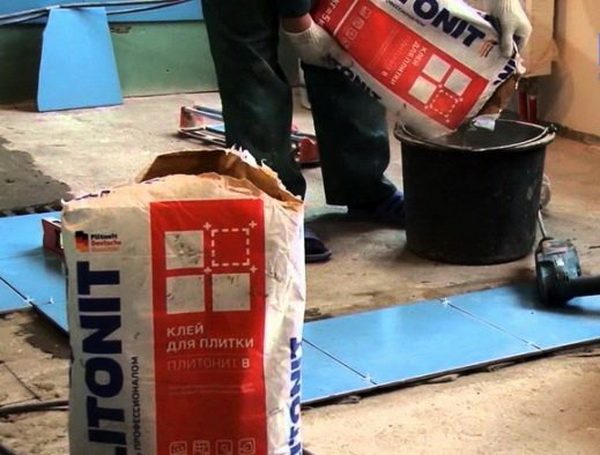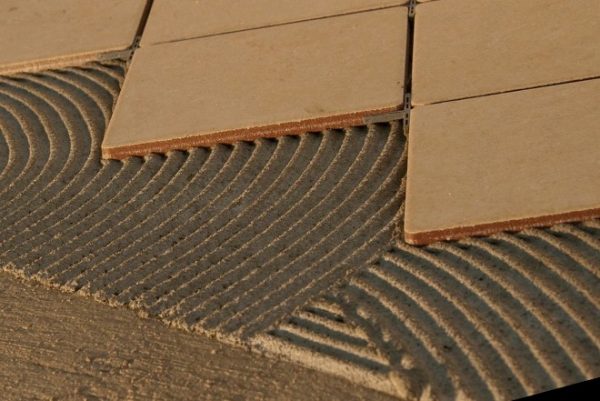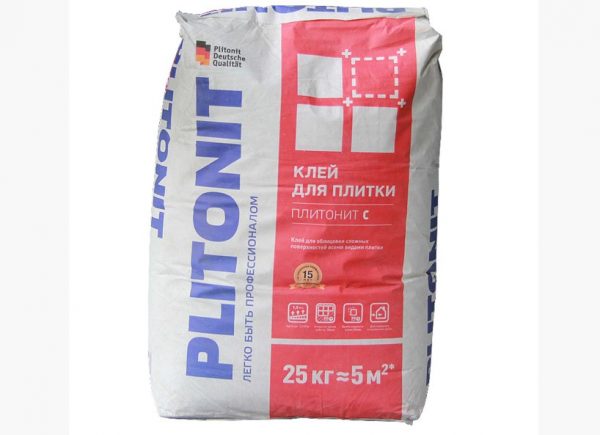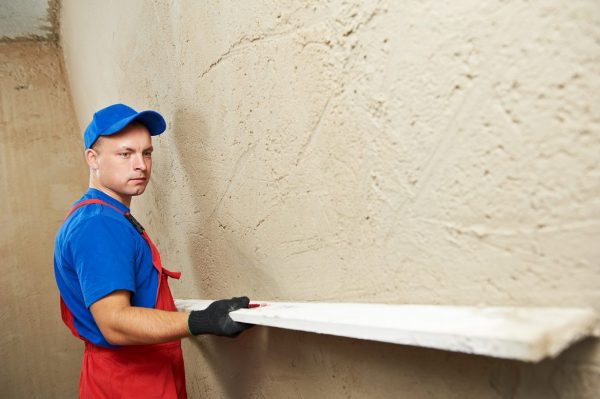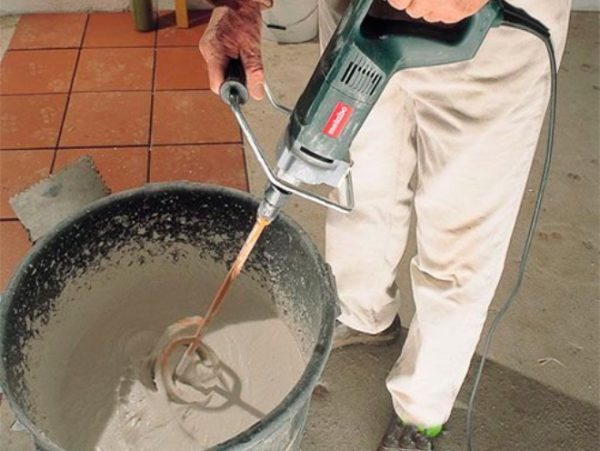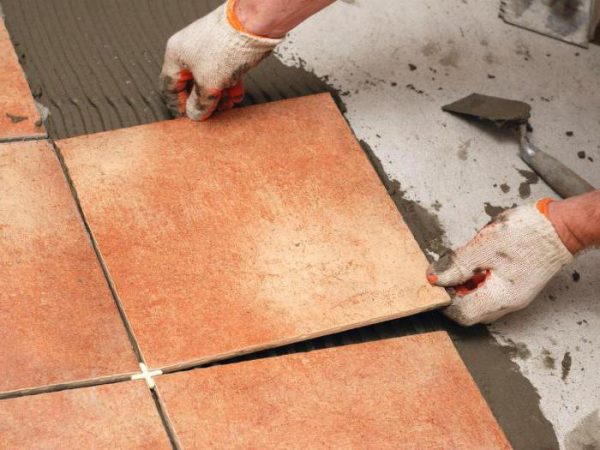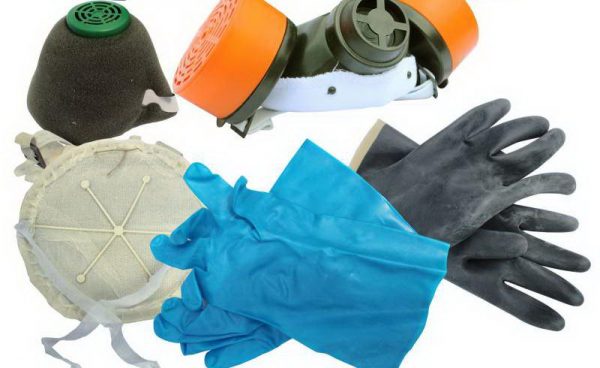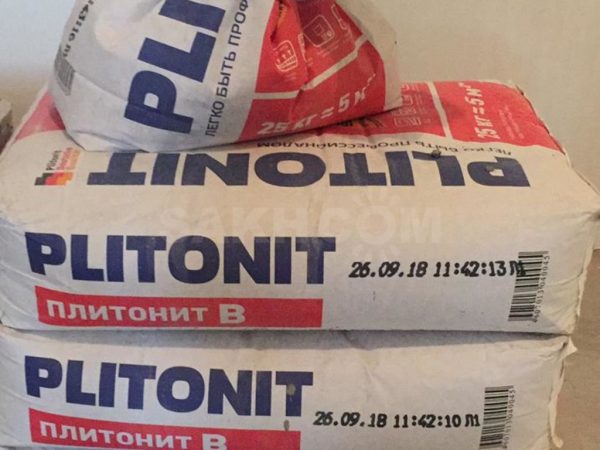Ceramic tile is a rather porous material: when using improper glue, it can be excessively saturated with moisture, which reduces the service life of the adhesive joint. For laying tiles, you need to use only specialized tools. One of the high-quality compounds is the glue “Plitonit”. There is a whole line of these adhesives, which have different purposes and properties.
- Specifications
- Release Forms
- Advantages and disadvantages
- Consumption rates
- Work procedure
- Preparation for work
- Mixture preparation
- Application subtleties
- Cost and positive features
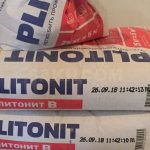
Specifications
The company Plitonit (Russia-Germany) produces a variety of products from the construction chemistry category, which are used by professionals and beginners for home use. The most popular adhesives for tiles, which are suitable for laying ceramics, porcelain stoneware, clinker plates on walls, floors. Tile adhesive can be used on a variety of bases:
- gypsum putty and plaster;
- concrete and reinforced concrete;
- brick;
- tongue-and-groove plate;
- floors with heating system;
- lime-cement slabs;
- coverings of indoor pools.
Tile adhesives "Plitonite" A, B or C-series are available in bags of 5 kg and 25 kg. Inside there is a homogeneous gray powder mixture, which is diluted with water in the ratio recommended by the instruction. The composition includes cement, other binders, adhesive additives, modifiers, fillers. The total grain size does not exceed 0.63 mm.
Glue has high ductility. This property allows you to reliably hold the tile, even on vertical and complex bases, not to let it slip. The main technical characteristics of the adhesive:
- glue line thickness - up to 10 mm;
- drying time before operation or grouting - 24 hours;
- temperature during glue application - from +5 to +30 degrees;
- operating temperature of the adhesive joint - up to +60 degrees;
- maximum tile sliding - up to 0.5 mm;
- time for adjusting the position of the tile - 15-20 minutes;
- the viability of a portion of the solution is 4 hours;
- frost resistance - F35;
- adhesive adhesion with a concrete base - 0.6 MPa for ceramics, 0.5 MPa for porcelain stoneware;
- compressive strength - M50.
The service life of the adhesive in the package is 12 months. After this time, its basic properties can be reduced.
to contents ↑Release Forms
The stores offer a huge assortment of Plitonit products. The user has the opportunity to choose the right material depending on the requirements, the properties of the tiles and the base. The most popular adhesives:
- "Plitonite A". Typically, this tool is used as a universal masonry mortar. Suitable for different types of tiles, does not slip on vertical surfaces, is well fixed on horizontal bases. "Plitonite A" has excellent moisture resistance.
- "Plitonite B". The material includes additional additives that increase its frost resistance. Suitable for ceramic tiles and porcelain tiles.
- "Plitonite B +". The water resistance of this composition is increased, because it can be used for finishing work in wet rooms, pools, saunas. Thanks to frost resistance, the mixture is used for various facade works.
- "Plitonite Express Wb."This glue has all the properties of "Plitonite B", but has a higher drying speed (quick-hardening composition). Already after two hours, you can grout the joints, so the glue will come in handy during emergency work.
- "Plitonite In Maxisloy." Used for surface finishing with large-format plates, stone blocks, provides a high degree of adhesion. The product can be applied with a layer of up to 30 mm.
- "Plitonite To Clinker." Specialized composition for laying clinker, stone, does not shrink, has high reliability.
- "Plitonite In Pro." Professional composition for complex work, suitable for mosaics, finishing socles and facades, terraces, balconies.
- "Plitonite To Superfloor." Used for flooring, made on a cement basis. Helps fill small and medium voids, level the floor.
- "Plitonite Superkamin Thermoglue." Suitable for cladding with different types of tiles stoves, fireplaces, other substrates, which will subsequently be heated. This adhesive can also grout heated surfaces. Operating temperature - up to +150 degrees.
- "Plitonite C". The composition is applied on problematic grounds - on old ceramics, paint, surfaces with residues of other glue. Also, the tool is suitable for gluing tiles outside buildings and in pools.
- "Plitonite With Marble." Specialized adhesive for marble decoration, has high moisture resistance, quickly hardens (in 8 hours), suitable for swimming pools.
Advantages and disadvantages
The use of tile adhesives of this brand has a lot of advantages. The dry mixture is very convenient to knead, it does not form lumps and almost immediately turns out to be smooth, homogeneous. Other advantages:
- Excellent adhesion. The composition includes special additives that provide a high degree of reliability of the mixture, it firmly holds the tile on the base. For large-format plates it is recommended to choose specialized Plitonit adhesives that are able to hold heavy material.
- Elasticity. This property is especially valuable for laying tiles subjected to dynamic loads (for example, in new homes that shrink). Glues "Plitonit" are able to compensate for the hardness, brittleness of ceramics, not allowing it to deteriorate. Flexible compounds are widely used for flooring.
- Moisture resistance. All adhesives are moderately moisture resistant by default, but some have enhanced ability to withstand the effects of water. They are used for lining pools, walkways, porches.
- Frost resistance. Some adhesives of the Plitonit series can be used not only for internal but also for external work - they perfectly withstand several cycles of freezing and thawing. After thawing, the adhesive seam does not crack, does not crumble.
- Wear resistance. Glue "Plitonite" serves a very long time, as well as the main material. Especially strong are the means of category C.
Among the pluses, it should also be noted:
- convenience of kneading;
- ease of application;
- high drying rate;
- minimum installation time;
- low price;
- extensive scope.
to contents ↑Among the minuses, you can only indicate the need for high-quality preparation of the base, otherwise the laid materials will lag behind the surface. Packages of less than 5 kg are not on sale, therefore, for gluing tiles, you still have to overpay for the unnecessary volume.
Consumption rates
The average consumption per 1 m2 of Plitonit glue can vary depending on various factors. It is 1.7-5 kg / sq. m and is determined by the following indicators:
- tile size (the larger it is, the greater the consumption due to an increase in the layer thickness);
- tile material (tile absorbs glue more than ceramics);
- the evenness of the base and the quality of its preparation (more glue will have to be applied to uneven surfaces);
- the method of applying the solution (solid or toothed spatula);
- skills of the master (beginners often admit loss of glue, roughness of the adhesive layer, etc.).
Work procedure
Before starting work, make sure that the environmental conditions comply with the manufacturer's requirements. It is important that the temperature during operation does not exceed +30 degrees and does not fall below +5 ° C. The same temperature should be when drying the laid tiles for the next three days from the moment of work. You can start operating the floor and walls earlier - 24 hours after the end of the tile installation (for glues with express drying this time is lower). At the same time, it is allowed to start grouting tile joints.
to contents ↑Preparation for work
First you need to evaluate the state of the tile itself. Adhesive adhesion can decrease if there is dirt, dust, grease on the base material. The tiles must be cleaned, dried thoroughly, soaked in water should not be. Next, it is important to make sure the foundation is ready for work. It should be strong, strong, without falling off parts and elements. Otherwise, such areas will peel off along with the laid tiles. It is important that the base is not subject to deformation, as well as being flat, without major differences.
Other recommendations for surface preparation:
- thoroughly putty all cracks and cracks, then process with sandpaper;
- clean dirt, grease, dust, wash, degrease the base;
- porous materials (for example, aerated concrete) primed 1-3 times;
- for priming drywall, it is better to use compositions of the same brand, which include antiseptic and fungicidal additives;
- floors must be treated with antifungal solutions, especially if they are located in rooms with a high level of humidity.
Mixture preparation
All components for the preparation of Plitonit glue must have room temperature (dry mix, water). Actually glue needs to be kept warm for at least several hours. For kneading, clean buckets are used, other containers in which there are no foreign impurities, pollution. Tools should also be clean: a construction mixer, a drill with an appropriate nozzle. Residues of glue and other mortar from tools must be removed, otherwise the quality of the composition will decrease.
The water for the preparation of glue should also be clean, it is better to take drinking water, since the technical one usually has foreign chemical impurities. To pour out the dry mixture, use a trowel. 0.24 liters of water are taken per 1 kg of powder. A large package of 25 kg needs about 6 liters of liquid. The order of dilution of the funds is as follows:
- pour water into the container;
- pour dry powder;
- mix glue with a mixer.
In the end, it is important to get a completely homogeneous solution in which there are no lumps. If the mixture is prepared correctly, when applied to the wall, it does not drain down. In this case, the desired consistency is obtained. Next, the material should be left for 5 minutes, then mix again. Periodically knead the solution during its use (4 hours).
to contents ↑Application subtleties
Apply glue with a smooth or notched trowel. Professionals recommend using a smooth tool, but after giving the adhesive layer a comb structure - so adhesion with the base will increase. Do not immediately apply glue to too large an area - a dry crust may appear on the composition, which will have to be removed and replaced with a new solution.
Features of work with glue "Plitonit":
- after applying glue, a tile is placed on it, careful turning movements are made, while individual elements are pressed into the solution;
- crosses between the tiles, observing the correct size of the inter-tile seam;
- within 20 minutes, adjust the location of the tiles, if necessary, using a laser level for clarification;
- excess glue is immediately removed with a metal spatula, knife, not allowing them to freeze;
- the outer side of the tiles is rubbed off the glue with a rag, a damp sponge.
When laying tiles on underfloor heating or when using large-format materials, voids may form under the coating. In this case, it is recommended to use a combined method of applying glue - on the base and on the inside of the tiles. For this purpose, use only a notched trowel, otherwise the layer will turn out too thick. If necessary, then align the glue with a smooth tool.
It is very important not to use the floor until the mixture has completely dried (24 hours). If the glue has not gained maximum strength, the tile can move, and where the layer of the product was too thin, it peels off altogether. Heavy physical effects on the floor (for example, furniture movement) cannot be exerted within 3 days, and it is forbidden to connect a warm floor in the next 7 days. On the contrary, additional uniform heating of the air in the room will accelerate the complete drying of the glue.
to contents ↑When working with glue, personal protective equipment must be used, which is especially important when mixing the solution. To prevent the dry mixture from getting into the airways and eyes, use a respirator and glasses. Gloves are always put on hands during work. If the product gets on the skin, it is washed with plenty of water.
Cost and positive features
The price of the “Plitonit” package of series B is 160-200 rubles / 25 kg, the cost of series C adhesives is higher - up to 300-320 for a similar pack. You can purchase material at any hardware store. Experts note a moderate price of glue with many advantages - impeccable strength, high reliability, ease of use. “Plitonite” is perfectly combined with any bases and types of tiles, universal, safe in composition, which makes it one of the most popular products on the market.

